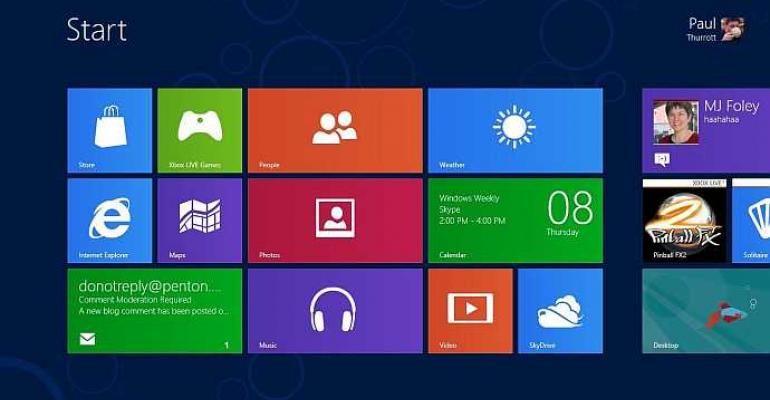For over a year now, I’ve struggled to understand Windows 8 (and Windows RT) and to effectively communicate the many changes that Microsoft has added to this release. What I’ve arrived at is that Windows 8 is nothing less than a new mobile platform that happens to bring along compatibility with current-generation desktop applications, and that Windows RT is the purer version of this future vision, with less backward compatibility but more mobile-oriented aspirations. And that’s all fine. But the big question is … why? Why did Microsoft throw a grenade into the middle of Windows and institute the biggest-ever change in this platform?
The answer is simple, as it turns out. And the clues to Microsoft’s thinking have been sitting right in front of us for the past three or four years. In our hands, actually.
I’m referring of course to smartphones and tablets.
And though we might continue to discuss market share in the increasingly irrelevant market for traditional PCs for a few years to come, there’s little doubt that the aggregation of these devices—smartphones, tablets, and PCs—represents the future of personal computing. I think of these things collectively as personal computing devices. And although they don’t necessarily compete directly with one another in all cases (some consumers will own at least one of each), they can each be the only such device that others use to consume computing services.
Microsoft has dominated the traditional PC market since there’s been one. Today, about 95 percent of all PCs sold are running Windows, and about 95 percent of all PCs in the world are running Windows. These figures haven't really changed much over the years, and they won’t change markedly going forward.
The trouble is that PCs are increasingly a smaller part of the wider market that is personal computing devices. Although sales of tablets aren’t expected to surpass those of PCs until 2015-2016 at the earliest, analysts agree that the day is coming. Sales of smartphones have already done so. Forrester, for example, expects total smartphone sales in 2012 to be about 660 million units—almost double the 360 million expected PC sales this year.
Looked at collectively, the market for personal computing devices is approximately 1.2 billion this year. And Microsoft’s share of that wider market isn’t quite so high. It’s about 30 percent, at best.
Given market trends, sales of smartphones and tablets are going to continue to rise. Again using Forrester’s numbers, we can expect Microsoft’s share of the personal computing devices—again, combined sales of smartphones, tablets, and PCs—to be about 30 percent in 2016, as well, better than Apple (iOS) and slightly behind Google (Android).
I’ve argued in the past that the future of personal computing is more heterogeneous, and this coming spread—with the move to more mobile-computing-device form factors—explains how we get there. It also explains why Microsoft has so radically changed Windows with Windows 8: It is adapting a desktop-oriented, traditional PC operating system explicitly for the tablet portion of this market. And with Windows Phone 8, which is based on Windows 8, it is doing so for the smartphone portion as well.
This, too, explains why Microsoft now refers to itself as a “devices and services” company. It makes the platforms that run on each device type—Windows 8 (PCs and other computing devices), Windows RT (tablets and other computing devices), and Windows Phone 8 (smartphones). And it makes the services that provide these platforms with their true differentiators—Office 365, Office 2013, Microsoft account, SkyDrive, Xbox LIVE video games and entertainment, and so on—services that, go figure, work best on Microsoft-oriented devices.
The thing is, even though Microsoft is “losing” market share going forward thanks to this shift, it will in fact still grow and command a bigger overall market than it does now. As I explained yesterday in "Embracing a More Heterogeneous Future," the market for Microsoft-oriented devices in 2016 is expected to be roughly 600 million units. That’s much higher than the ~360 million PCs that it will sell this year, and though the margins on software for smartphone and mobile devices are no doubt smaller than those for PCs, Microsoft will continue to dominate that latter market. So this should represent a period of great growth for the one-time software giant.
As a side-note, I’ll also point out an interesting trend that appears in this more heterogeneous personal computing world of the near future: Each of the three major players—Apple, Google, and Microsoft—will control, to some degree, one facet of this market by 2016. By that time, Forrester says, Apple will control 41 percent of the tablet market, with Google, Amazon (sort of Google) and Microsoft splitting the rest; Microsoft is expected to own about 27 percent of the tablet market.
In the smartphone market, Android will rule, with about 60 percent market share, followed by Apple (25 percent) and Microsoft (14 percent). And in the PC space, Microsoft will continue to dominate, with about 90 percent market share; Apple will sop up much of the remaining 10 percent, while Google is basically missing from the PC market.
This kind of market diversity is healthy, and good for consumers, and it creates a great battlefield for these firms to duke it out in various ways. For Microsoft, the future is an open opportunity, and by moving quickly to adapt Windows for both devices (Windows 8, Windows RT) and smartphones (Windows Phone 8), it's not just proving to be surprisingly spry for a company of its PC-based heritage but also quite forward-leaning. Microsoft will continue to be a major player in the personal computing market going forward, and will in fact continue growing as a result.
And it’s all going to happen thanks to Windows 8.
That's why.




